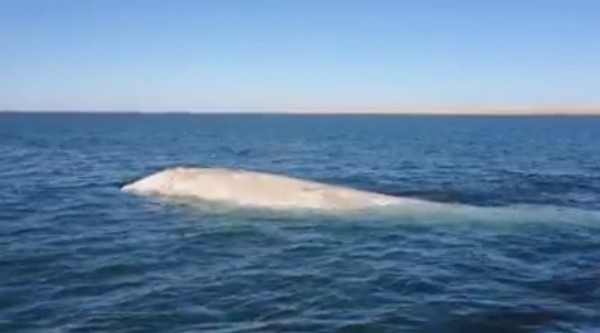By Ana Verayo, | March 06, 2016

Extremely rare "Gallon of Milk" albino gray whale spotted in Mexico.
An extremely rare albino whale was spotted off Mexico's coastal waters where conservationists have been conducting a yearly whale census. This female albino gray whale known as "Gallon of Milk" was seen by environmental officials, as they also revealed that the female whale was last seen in 2009.
Like Us on Facebook
A video of the rare whale was posted on Facebook by the National Commission of Natural Protected Areas, showcasing the whale that is freely swimming near the waters of Baja Calfornia Sur island, along with a small baby calf. The calf appears to have normal coloration unlike its pale mother.
Scientists first documented "Gallon of Milk" during 2008 to 2009, as it also belonged to an annual population of gray whales that migrate to the region during breeding season.
According to the National Commission of Natural Protected Areas, for this year alone, there are 2,211 gray whales that appeared in the lagoon of Ojo de Liebre at the El Vizcaíno Biosphere Reserve which is a rich biological landscape that has been monitored by biologists for decades. From those gray whales, 1,004 calves were born in Mexico.
This unique white whale exudes a certain kind of albinism derived from a gene mutation that triggers a sharp decrease of skin pigment known as melanin that has been almost never been recorded in marine mammals. Albinism in animals are more common among land dwelling creatures like birds, mammals, reptiles both in captivity and wild habitats.
This yearly monitoring is crucial as it helps secure the survival of the species of the gray whale which is also scientifically known as Eschrichtius robustus. This whale breed is also considered as highly endangered, where they migrate every year to the warm waters of Mexico for feeding and breeding sites. These massive creatures also have a lifespan of up to 70 years where they can weigh up to 40 tons and measure up to 50 feet in length.
Calves and young whales are able to pick up the migration patterns of their parents and pods, as calves usually follow their mothers to breeding areas and to forage around specific areas, according to Bruce Mate from the Oregon State University's Marine Mammal Institute.
Gray whale populations are now threatened by commercial whaling where the whales thrive in the eastern and western regions of the Pacific Ocean. The gray whale populations of the western Pacific regions are previously thought to be almost wiped out, as they are estimated to be only 130 of them left, leaving them critically endangered.
-
Use of Coronavirus Pandemic Drones Raises Privacy Concerns: Drones Spread Fear, Local Officials Say

-
Coronavirus Hampers The Delivery Of Lockheed Martin F-35 Stealth Fighters For 2020

-
Instagram Speeds Up Plans to Add Account Memorialization Feature Due to COVID-19 Deaths

-
NASA: Perseverance Plans to Bring 'Mars Rock' to Earth in 2031

-
600 Dead And 3,000 In The Hospital as Iranians Believed Drinking High-Concentrations of Alcohol Can Cure The Coronavirus

-
600 Dead And 3,000 In The Hospital as Iranians Believed Drinking High-Concentrations of Alcohol Can Cure The Coronavirus

-
COVID-19: Doctors, Nurses Use Virtual Reality to Learn New Skills in Treating Coronavirus Patients







